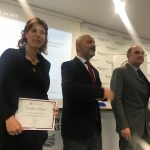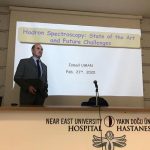
Within the scope of the periodic conferences of the Near East University Experimental Health Sciences Research Center, Prof. Dr. İsmail Uman and Dr. Sercan Şen from Hacettepe University carrying out research activities especially on particle physics and light quark spectroscopy made a presentation each.
According to the information provided by the Press and Public Relations Directorate of Near East University, at the conference held in the 101th Hall of the Near East University Hospital, Prof. Dr. İsmail Uman made a presentation titled “Hadron Spectroscopy: Latest Technological Development and Future Challenges” and Dr. Sercan Şen made a presentation titled “Machine Learning Applications Using CERN Open Data”.
Prof. Dr. İsmail Uman, mainly focusing on research activities on particle physics with light quark spectroscopy since 1996, explained that the Hadron Spectroscopy is related to resonances consisting of light u, d and s type quarks and was performed by analyzing high energy physics data collected at Crystal Barrel (CERN), E835 Fermilab, COMPASS (CERN) and BESIII in Beijing, China recently.
Prof. Dr. Uman said: “The Particle Physics Standard Model predicts that nuclear matter is made up of quarks and leptons, and gluons, photons, and W and Z bosons are fundamental particles that mediate strong, electromagnetic and weak interaction, respectively. According to the Quantum Chromo Dynamics theory, hadrons are grouped in two families: mesons consisting of quark and anti-quark pairs (example: pions and kaons) and barions of three quarks (example: protons and neutron). However, unlike photons that do not interact with other photons, gluons can also interact with each other, so that nuclear material can also form from gluons, and there may be glueball (particles consisting of two or three gluons linked together) and hybrids (particles made up of interconnected quarks and gluons). Also, beyond the simple quark model, it can be found in four quatra (tetraquark) or five quatta (pentaquark) connected situations.”
Prof. Dr. İsmail Duman during his presentation shared the technological advances and future challenges in hadron spectroscopy, as well as his studies conducted to observe these new nuclear forms and determine their properties.
Data Analysis to be Used in CERN Machine Applications were explained with LCH Experiment.
Dr. Sercan Şen, on the other hand, presented information about the studies conducted in the Large Hadron Collider (LHC) experiment and introduced the open-source applications that can be used in LHC experiments and data collection systems in CERN, data sets in CERN Open Data Portal and analysis of data.
Dr. Şen, in his presentation, where he mentioned the concepts of machine learning, deep learning and artificial intelligence, explained the basic difficulties in data analysis in high energy particle physics.
Dr. Şen speaking of LHC, the first and most powerful particle accelerator in the world and which is a part of the accelerator complex of the European Nuclear Research Center CERN and was launched for the first time in 2008, said “In two separate vacuum tubes in the LHC chain, the proton beams that are accelerated up to near the speed of light in opposite directions are collided every 25 ns (40 million times per second) at four collision points on the LHC ring. At each collision point, there are particle detectors (ATLAS, CMS, ALICE and LHCb) that collect the information of the particles released as a result of collisions. These detectors usually surround the beam collision point in such a way that they can capture most of the particles that will form, and are made up of sections with special functions such as tracing the different particles formed, measuring the energies they carry. In 2014, CERN shared some of the proton-proton collision data collected in LHC experiments through the CERN Open Data Portal (CERN Open Data Portal) so that it can be used by larger audiences for research and education purposes. The first high-level analyzable data transferred to the open data portal are data from the proton-proton collisions collected in the CMS experiment in 2010. Apart from being a data-sharing platform, the open data portal is a platform that includes all open source software and documents that will direct its users to be able to read and analyze the data. The latest version of the CERN open data portal, published in 2019 since 2014, contains many new applications and datasets for machine learning to overcome the difficulties encountered in the analysis of LHC data. Machine learning is an artificial intelligence application that gives systems the ability to learn and develop automatically, without being programmed explicitly. Data sets that can be used in machine learning applications in the latest version of the CERN open data platform are: Simulation data for analysis of events involving two b-quarks in the decay of the Higgs boson, simulation data for events involving top-quark, and data that can be used in detecting particle traces in detectors in LHC collisions that will be carried out in the future at high beam. These data can be analyzed using the ROOT data analysis program.”


